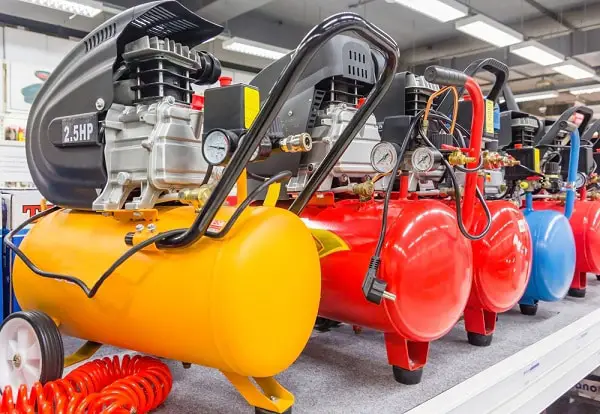Connecting two compressors together should be fairly straightforward, and it is, as long as you remember to use a couple of check valves in the plumbing as well. Here is more on that.
Also, this is page three about combining air compressors to increase flow. The first page of information is here.
Most smaller air compressors come equipped with a coupler into which an air line is plugged, Air then flows down the line to the air tool. To connect two compressors together simply plug an air line into each coupler on each air compressor, and connect those two air lines together with a Tee.
The air lines can be shortened to make connecting the two compressors together if preferred.
A single line would be plumbed from the Tee to the air tool, and there would then be two compressors connected to one tool. Don’t forget the check valves, though.
The check valves should be installed in the line from each compressor, before the lines connect at the Tee. The check valves are installed so air can flow away from the compressor, but not towards it.
In this way, if one compressor is pumping and the other is not, air from the working compressor cannot flow back down the line to the other compressor, and out through the unloader valve.
If sufficient air is drawn so that both air compressors cycle on, all air being compressed can flow out, through the check valves, and down the common line to the air tool.
Adjust the pressure switches?
If the pressure switches from both compressors have similar cut in and cut out, then both compressors will work approximately the same amount, depending on the air demand of the air tool.
If the gap in cut in between the two switches is too great though, one compressor may be doing all the work, starting and stopping much more frequently than the other.
Ideally the cut in for one compressor would be about 5 PSI below the other, with a similar differential setting for cut out. As air demand exceeds the capacity of one compressor, the minimal pressure differential would mean that the other compressor would start almost immediately.
If, however, the capacity of one compressor was sufficient for the air tool most of the time, one compressor may still be doing the brunt of the work. That being the case, periodically, consider changing the pressure switch settings so that the secondary compressor becomes the primary, and the reverse.
Connecting two air compressors together can resolve the capacity shortfall of one compressor, for sure. It is important to make certain that the increased CFM available from the compressors is sufficient for the range of air tools required to do the work, or, your only other option is to acquire a larger compressor.


